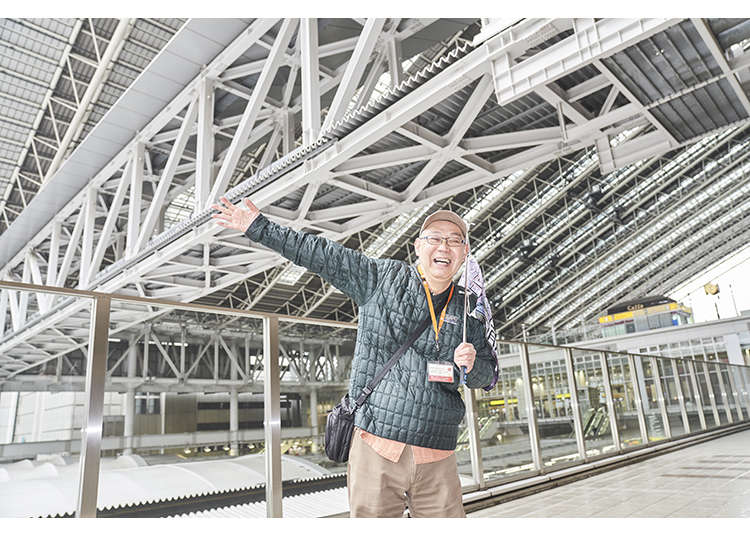
Osaka Station opened in 1874, and the current building is the fifth iteration of the station. As the station constantly grows and changes, even frequent visitors can always uncover new hidden gems they've never seen before! I'm Take, a professional Osaka tour guide, and today I'll show you some fascinating spots right here in Osaka Station.
*This article includes advertising content.
- Table of Contents
-
- Osaka Station turns 150! The history panels by the South Gate Plaza
- Can you hear the chime of the Meiji period (1868-1912)? The Departure Bell continues to send passengers off
- See all of Osaka City Station in an instant! Two scale models
- Where do they go? Who uses them? Mystery passages
- New discoveries at the iconic symbol: The Golden Clock!
Osaka Station turns 150! The history panels by the South Gate Plaza
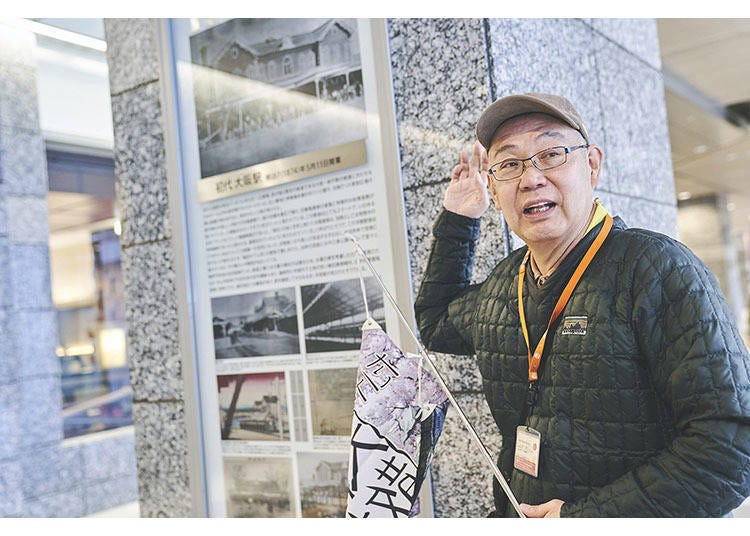
Let's start by learning more about the station's history. The perfect place to do so is by the informational panels in the South Gate Plaza. This area is less trafficked than others, but it's packed full of Osaka Station's incredible history.

We'll start with the very first Osaka Station building. It opened in 1874. That was 150 years ago, so it's safe to assume no one reading this was born yet.
Take a look at this photo. It was such a fancy station, right?
If you look in front of the station, you'll see a ton of rickshaws waiting for customers, but not much else. Back in the day, there was nothing around here.
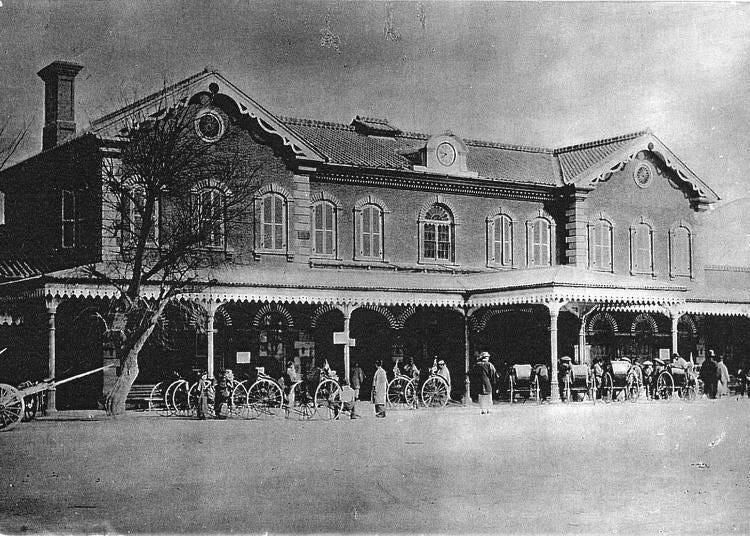
There are several Japanese kanji characters that are pronounced "ume" and each has its own meaning. Originally, Umeda was written using the character meaning "to fill in" because the unstable wetlands in the area had to be filled before the station was built.
At first, they had planned to build a little further south in the Dojima area. However, citizens protested the idea of steam locomotives running through their neighborhoods, as they worried about the excessive smoke and the possibility of fire.
Eventually, the "ume" character used in "Umeda" was changed to the character for "plum." The change was made because the character meaning "to fill in" is also used to describe filling a grave with dirt, and the association with death was thought to be unlucky. So, the "plum" meaning was adopted, a reference to plum trees that grew nearby. Nowadays we can't alter place names on a whim like that, but they weren't so strict back then.
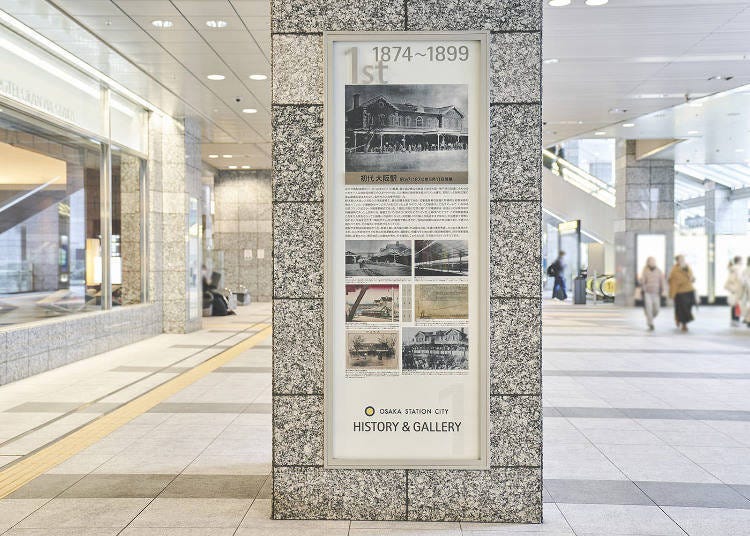
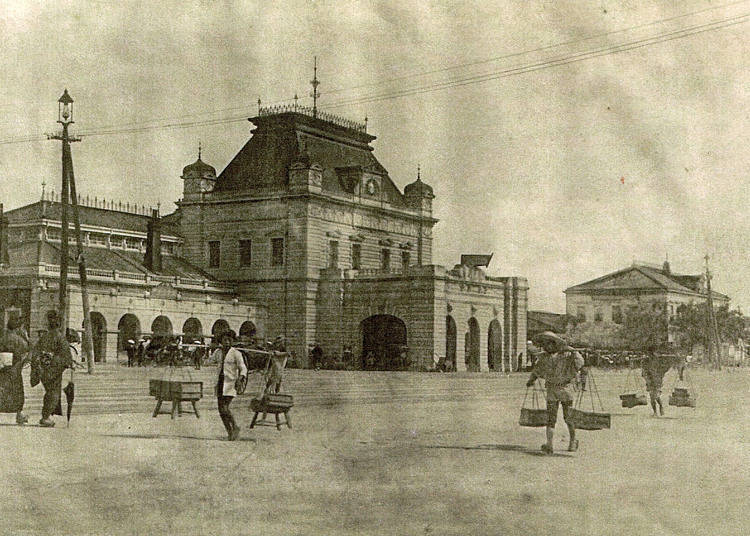
This second version of the station opened in 1901. At the time, Osaka was experiencing a rapid increase in population.
Where before there were only waiting rickshaws, here we see power lines and a parking lot full of carriages, plus there was a beer hall-style restaurant inside. The station was entering a lively and vibrant age.
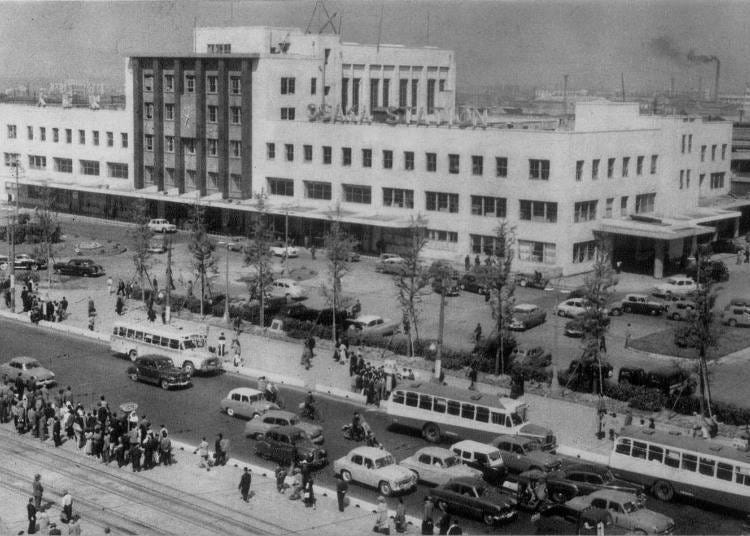
Now, for the third iteration, we arrive in the year 1940. I guess that no one reading this was alive then either? That was just a little before my time, too.
From the end of the Taisho period (1879–1926) to the early Showa period (1926-1989), Osaka's era of prosperity was coming to an end and the war in the Pacific was just about to begin.
This station building was used for about 40 years until 1979, and I think it's fair to say that the general shape of the current Osaka Station was developed during that time.
By the way, around this time, private railways were also operating. For example, in this photo from 1934, you can see the JR line (at the time the publicly-operated Japanese National Railways) and the Hankyu line (at the time called the Hanshin Express). The JR line was switched to the elevated tracks, and the Hankyu line was brought down from the elevated tracks to street level in a very short period of time. They did an amazing job.
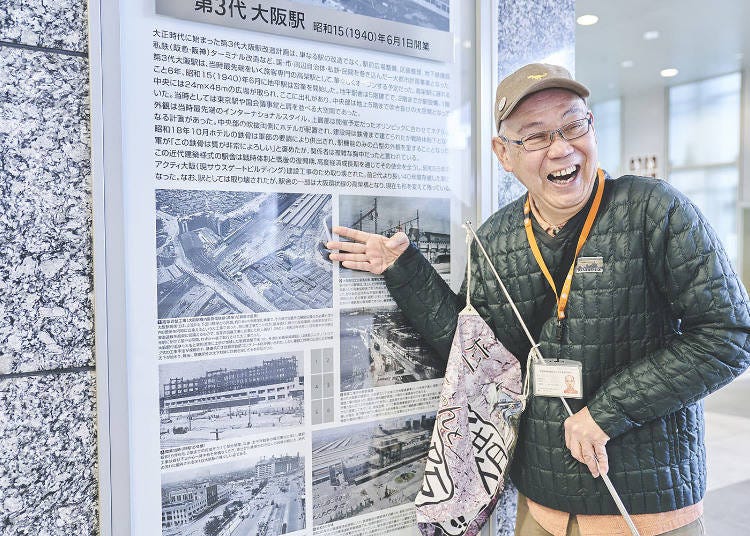
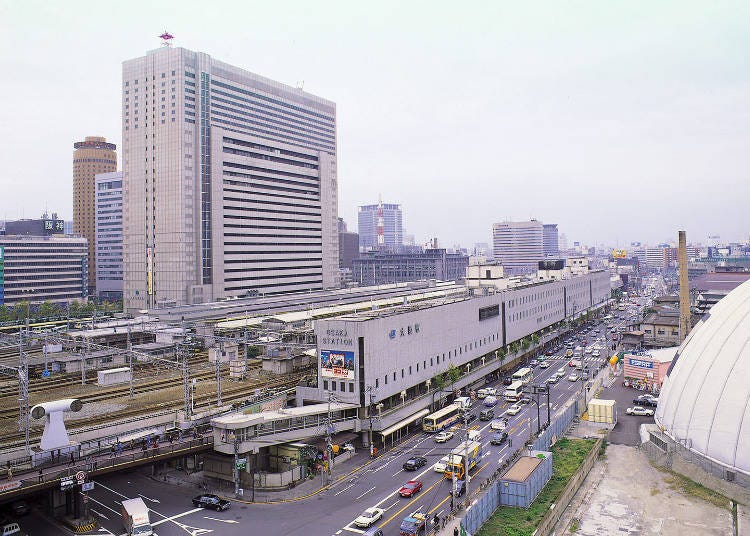
I think a lot of people may remember this one. The opening of the fourth iteration of the station in 1979.
On the other side of the main station building on the south side (left side of the photo) is ACTY OSAKA and the long, narrow building on the north side is the North Building. There are a lot of old coffee shops and restaurants there. When I was a child, my parents used to take me there and let me pick where we went for dinner. It was so much fun.
Around that time, the northern and southern halves of the station were completely separated. The town-like area built to connect the two sides in the fifth iteration is what is now called Osaka Station City.
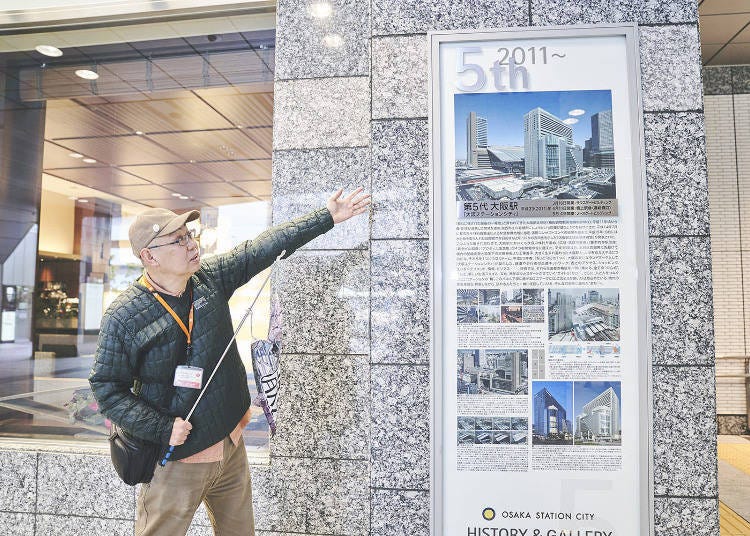
Osaka Station City opened in 2011. The South Gate Building, where we are now, was completed in March, followed by the elevated station building in April and the North Gate Building in May.
Looking back on all this history, Osaka Station is amazing, isn't it? Not a lot of stations have been rebuilt five times. This station has been at the forefront of progress in Osaka for all this time, and this year, it's turning 150 years old.
- History panels
South Gate Building, first floor, South Gate Plaza
Can you hear the chime of the Meiji period (1868-1912)? The Departure Bell continues to send passengers off
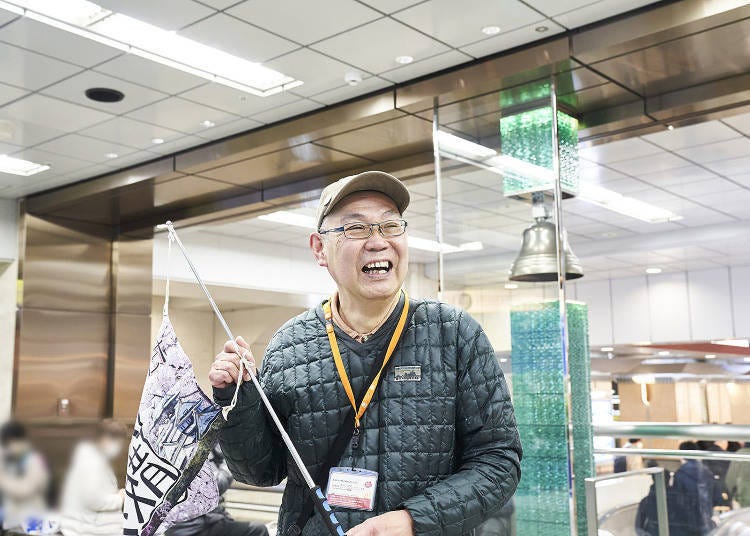
Did you know there's a major landmark from the first iteration of the station still present to this day? Let's leave the South Gate Plaza and go into the station building itself. This is the Tabidachi no Kane, or Departure Bell, which was used in the first version of Osaka Station to announce the departure of trains. Carefully maintained for all these years, the bell is still as shiny and beautiful as ever.
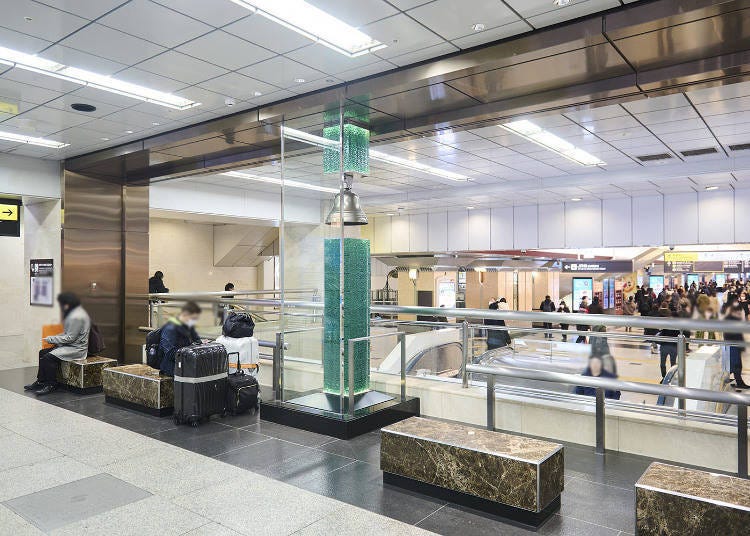
Though the bell is now a proud landmark and frequently used meeting spot inside the station, it actually spent a long time locked away in a warehouse.
It was removed for the duration of the Pacific War and stored in the stationmaster's office after. It was not until the completion of the fourth station building that it saw the light of day again, and was given the name "Departure Bell." However, it was removed again when the station underwent renovation. It was pretty busy all those years, getting pulled in and out of the station.
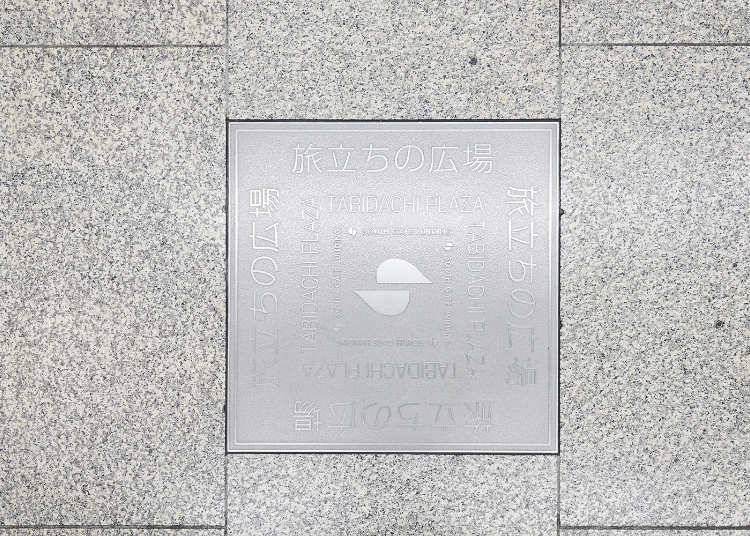
Tabidachi-no-Hiroba Plaza, where the bell is located, was created when Osaka Station City opened.
The bell rings at the start of every hour, but have a look inside the bell.
There's nothing in there. There's no clapper to make it ring, so they just play a recreation of the sound over the speakers.
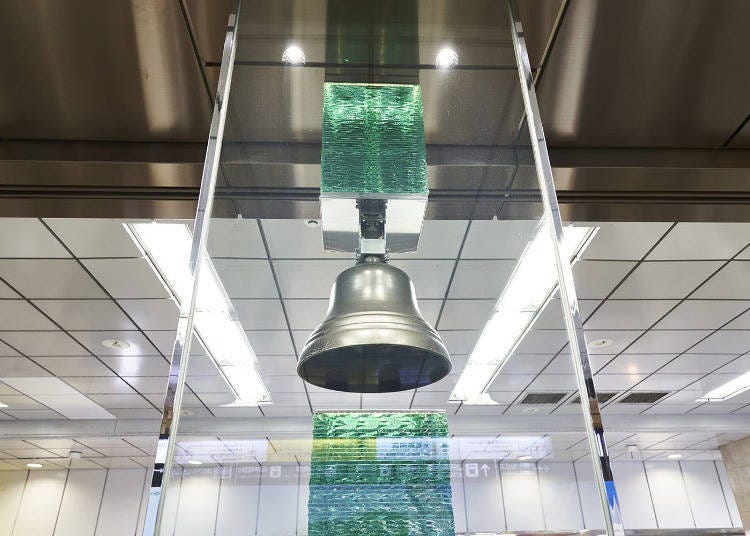
- Departure Bell (Tabidachi no Kane)
Osaka Station, first floor central concourse, Tabidachi-no-Hiroba Plaza
See all of Osaka City Station in an instant! Two scale models
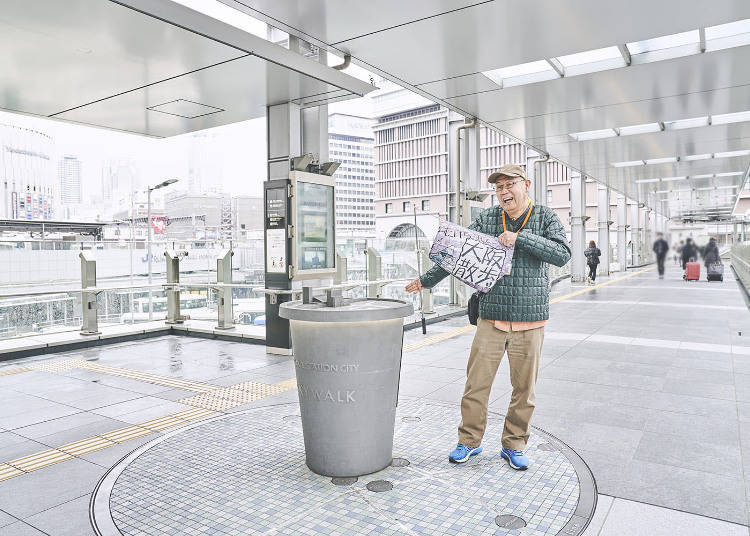
Next, let's talk about the current incarnation of Osaka Station. There's a helpful scale model that will tell you when each building was constructed. Let's go up to the second floor and head towards the overhead walkway that leads to the Hankyu Department Store.
Did you know that this passageway is called the "Skywalk"? A lot of people use this walkway, but I doubt many know the name, or even notice this model here.
Each building has the year it was constructed written on it. The building we're in, the South Gate Building, opened as the fourth station building in 1983 and has remained largely the same except for an expansion on the southern side. Since that was 1983, it's been over 40 years since then.
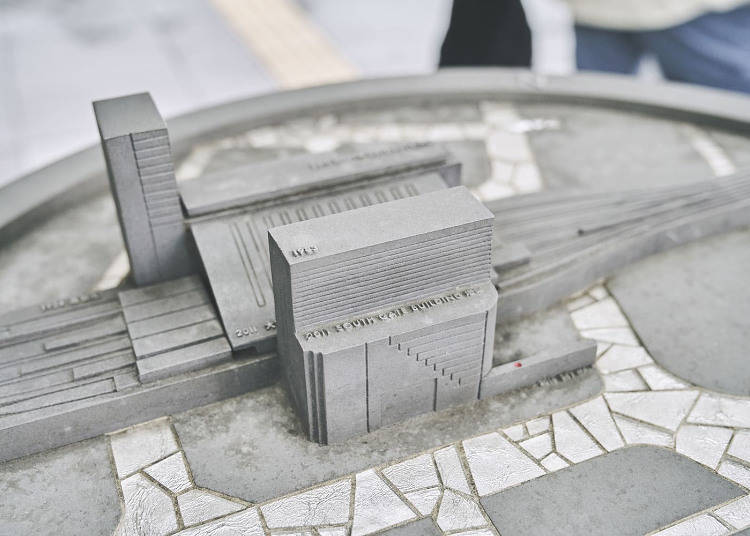
By the way, the white lines around the model are where roads are in real life. And if you take a good look beneath your feet, you'll find a map of the train lines. It even has the station names and the name of each line written on it. Isn't that neat?
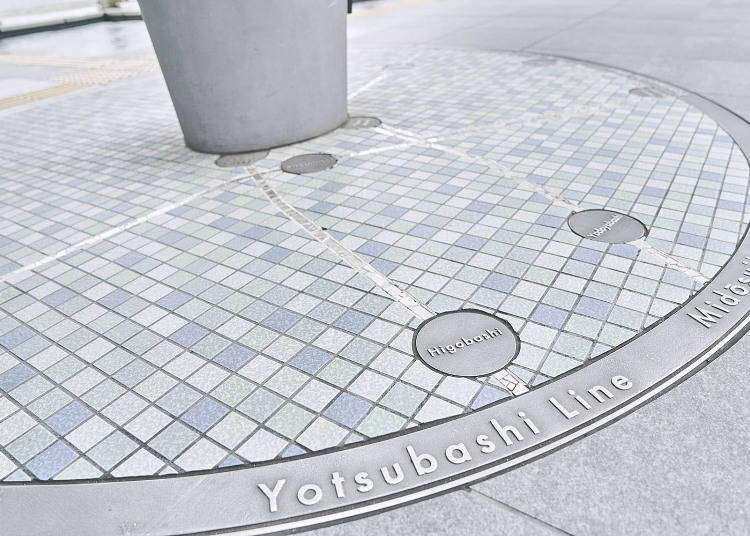
There is another model in the North Gate Building that I would like you to see, so let's head through the entrance to the adjoining office building on the third floor. It's an entrance to the office building, but sightseers and shoppers are allowed through here too.
The 1:300 scale is very detailed, and seeing it from above like this makes it easier to understand how everything is laid out.
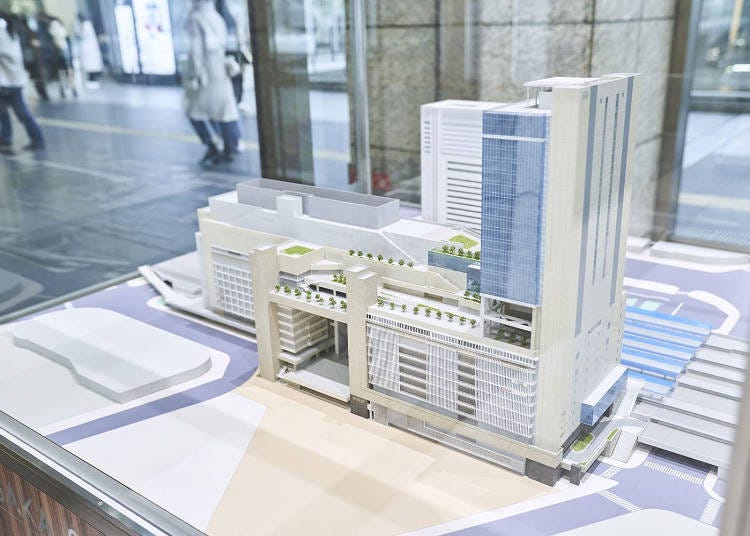
By the way, did you know that the large roof covering the station platform also helps collect rainwater?
It slopes from north to south to channel rainwater to an underground reservoir. The collected water is then used in toilets, for watering plants, and other uses. It's very eco-friendly.
Even the pipes leading to the water reservoir are included in this model. You see the pillar behind the orange train car? That's one of the pipes. The platforms on the Osaka Loop Line are always crowded, so sometimes I think these pillars are a bit of a nuisance. But if they exist to help the environment, then I can accept them.
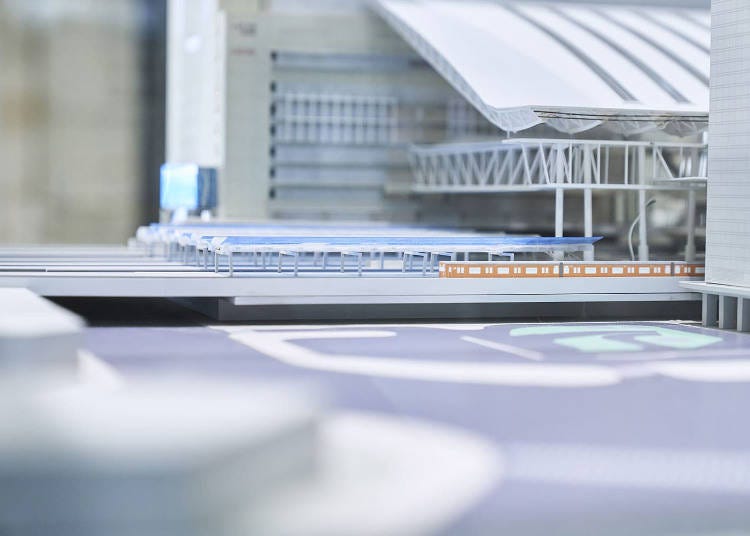
- 1:1200 scale model
South Gate Building, second floor, Skywalk
1:300 scale model
North Gate Building, third floor, office building
Where do they go? Who uses them? Mystery passages
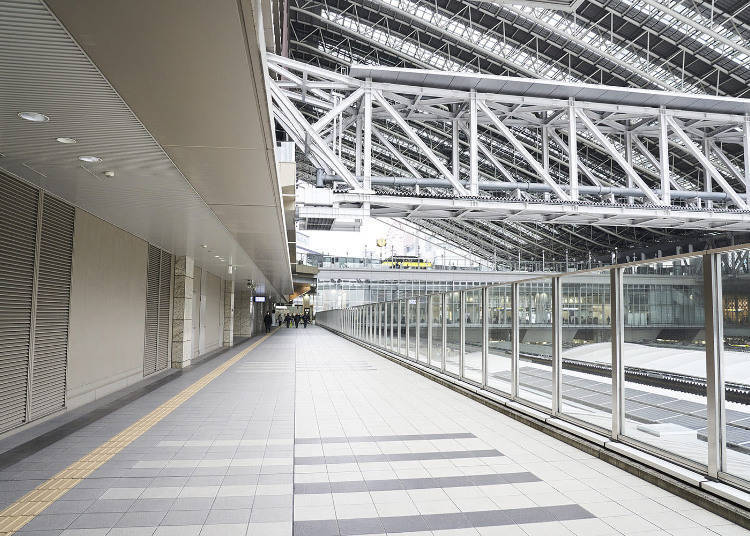
By the way, here on the third floor where we are now, there's a connecting bridge that goes right over to the ticket gates in Osaka Station. That's why there are so many people here. But even on this floor, there are some places where almost no one is walking. You're probably wondering why there's a passageway there at all if nobody uses it.
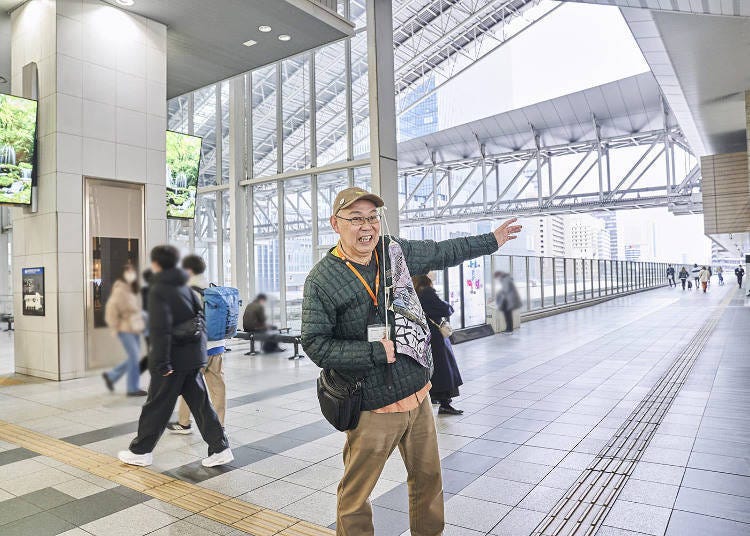
As you can see, there are hardly any people. It's a nice wide passageway with some restrooms. However, this is also a good place to stare at the large glass roof and watch the trains go by. And since there are no people here, you can take your time and enjoy the view.
Right now, Osaka Station's west side is still being built up, and once there are new ticket gates and buildings finished over there, this passage will see a lot more traffic.
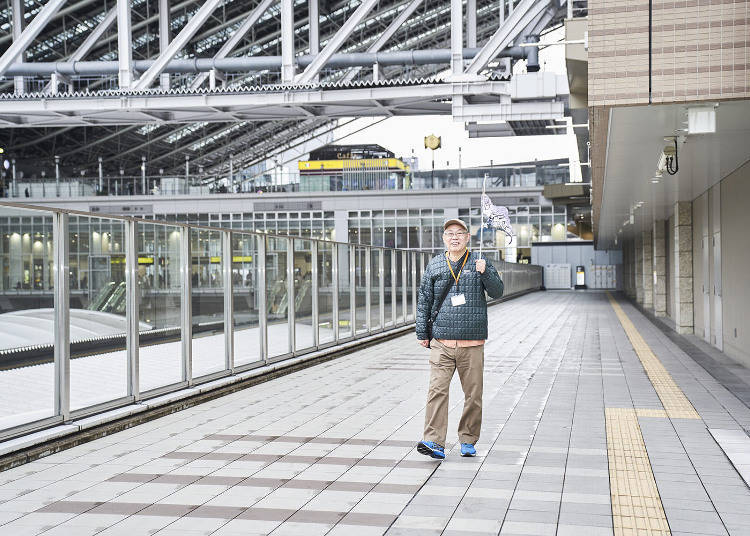
There's another passage like this on this floor (the third floor) but on the opposite side stretching to the east. This one is hidden behind some coin lockers and people don't realize it's even here.
If you go all the way to the end, you'll find stairs to the Carillon Plaza. It's a great way to avoid the crowds on your way to the Hankyu line.
- Mystery passages
North Gate Building, third floor
New discoveries at the iconic symbol: The Golden Clock!
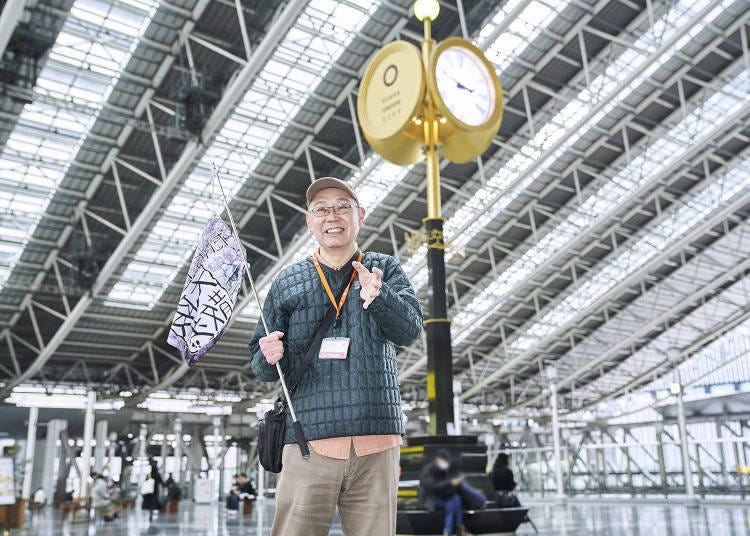
The last place we'll visit is the Golden Clock in Toki-no-Hiroba Plaza. This is already a pretty famous site, but did you know it's made with real gold?
If you look closely at the round part, you'll see the surface consists of tons of golden squares. That's gold leaf. The entire surface was covered in gold one square at a time by the Hakuichi gold-smithing workshop in Kanazawa.
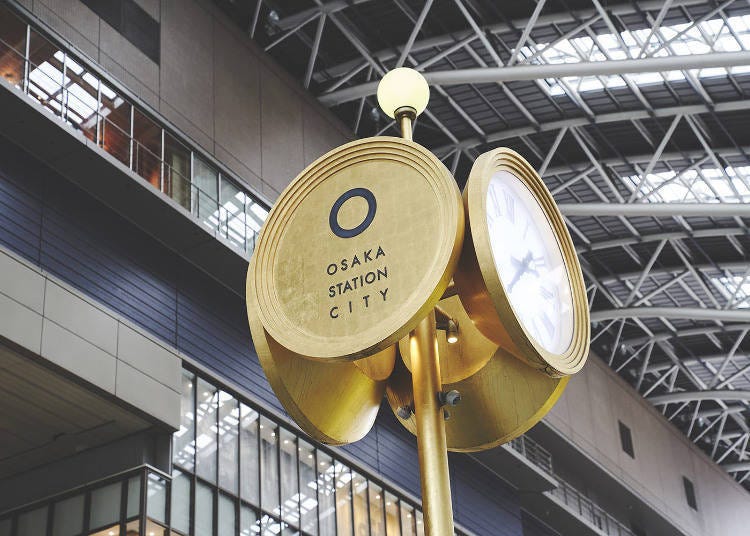
The pillars and benches are real black marble. Real marble doesn't stay cold even in the winter, as body heat is easily transferred to it. You can relax in comfort for hours in the wide-open space.
The Golden Clock can talk, though it doesn't have a voice.
If you look at the base of the pillar, you'll see some letters engraved there. It says, "Hello. I am the Golden Clock."
It also says that Mr. Golden Clock serves as a landmark and a host, watching over this lively meet-up spot.
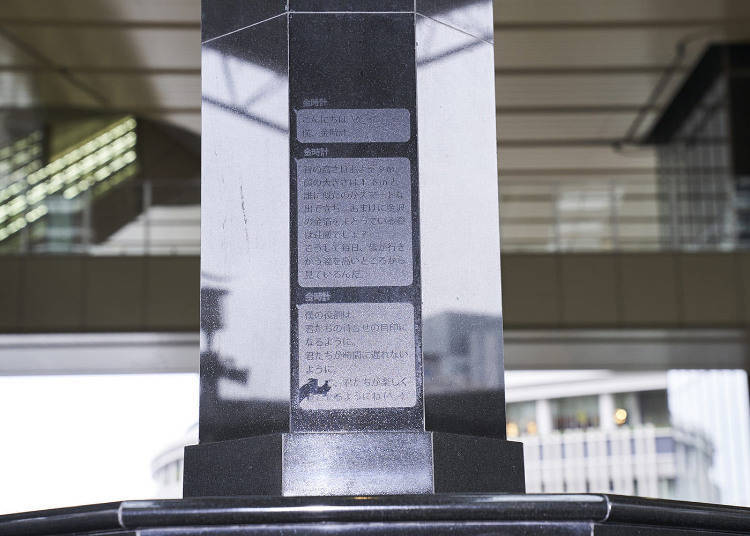
- The Golden Clock
Osaka Station Building, elevated station building, fifth floor
Final thoughts
I hope you’ve discovered something new about the places and landmarks you see all the time in Osaka Station.
Osaka Station City is massive, so if you go on a walk through here and keep your eyes open, you're sure to find something interesting.
Editor: Kotsu Shimbunsha
Writer: Take
- Take (Takesuke Okumura)
Born and raised in Osaka. A professional tour guide who's shown over 6,000 visitors how fun Osaka can be. He’s a fixture in Shinsekai and Dotonbori, and often gets approached by locals asking about his latest adventures. From information on delicious restaurants to fun trivia, walking the streets with Take is sure to be a fascinating and informative journey. He is a certified domestic tour guide and a certified domestic travel agency manager.
-

-
Address
3-1-3, Umeda, Kita-ku, Osaka-shi, Osaka, 530-0001
View Map -
Nearest Station
Osaka Station (JR Kansai Main Line / JR Tokaido Line / JR Kyoto Line / JR Osaka Loop Line / JR Kobe Line / JR Takarazuka Line / JR Osaka East Line)
- Phone Number 06-6458-0212
-
Address
3-1-3, Umeda, Kita-ku, Osaka-shi, Osaka, 530-0001
*This article was written based on information available at the time of publication in DOYA on March 27, 2023. Mentions of Osaka Station’s 150th Anniversary were rewritten in February 2024 to reflect the current year.
*Prices and options mentioned are subject to change.
*Unless stated otherwise, all prices include tax.
Popular Tours & Activitiess
-
Ad

Preserving the Beauty of World Heritage Site Shirakawa-go for the Future Through Responsible Travel
-

New Seibu L00 Series Launching in 2026! What to See Along the Tokyo-Area Golden Route
by: Guest Contributor
-
Ad

(Opening in Jan 2026) 'THE SUMO LIVE RESTAURANT HIRAKUZA GINZA TOKYO!' 5 Exciting Ways to Experience the World of Sumo!
-

Strawberries, Style, and Tokyo’s Coolest Neighborhood: Winter Afternoon Tea in Kichijoji
by: Guest Contributor
-

[Extended Offer!](12% OFF KKday Coupon) Mt. Fuji Autumn Leaves, Powder Snow & More! 15 Best Tours to Experience Japan in Fall & Winter
-

How to Get Don Quijote's Exclusive 2025-2026 Winter Gift (+Tax-Free Savings)
Inspiration for Accommodations
-

Spacious Family Hotel in Namba: 20 Comfortable Stays for Family Fun
-

Charming Hotels to Enjoy the Spectacular Views of Arashiyama's Autumn Leaves from Your Room
-

Experience Stunning Views of Osaka Castle from Private Spaces: Top Hotels Near Osaka Castle
-

Recommended by Visitors! Arashiyama's Best-Rated Hotels
-

Family-Friendly Universal Studios Japan Hotel with Excellent Access
-

Enjoy a Comfortable Stay in Osaka! 10 Hotels with Convenient Airport Shuttle Services
-

Top 10 Recommended Hotels Near Namba Station with Great Access
-

Enjoy Night Views from Your Room! Recommended Hotels in Namba Area
-

Top 3 Restaurants: Best Sushi in Dotonbori According to a Local Food Critic
-

38 Best Things to Do in Kyoto: See, Eat, and Shop Your Way Through Japan's Cultural Capital
-

3 Best Izakaya In Osaka Where You Can Enjoy Drinks and Local Dishes, Recommended by Locals
-

Unique Osechi for 2022 You Can’t Miss: Meat Osechi and Dessert Osechi?!
by: Ran Tanaka
-

10 Japanese Goods to Beat Hay Fever in 2021 - Carefully Selected by LOFT Umeda Staff!
-

Top 10 Fun Things to Do in Umeda Osaka - Recommended by Osaka Locals!
- #best gourmet Osaka
- #things to do Osaka
- #what to do in kyoto
- #what to bring to japan
- #best gourmet Kyoto
- #new years in Osaka
- #what to buy in nanba
- #Visiting Osaka
- #onsen tattoo friendly arima
- #daiso
- #Visiting Kyoto
- #best japanese soft drinks
- #japanese fashion culture
- #japanese convenience store snacks
- #japanese nail trends














